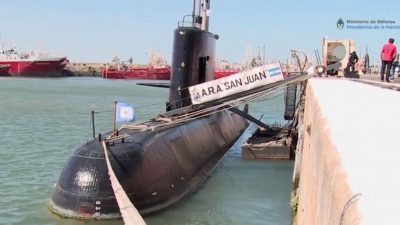The Vanishing Submarine: Hope and Argentina’s ARA San Juan

“Once a submariner, always a submariner.” Douglas Renken, Canadian submariner, CBC, Nov 26, 2017
A certain type of grief and moroseness accompanies deaths at sea. Not being naturally adapted to living in water, humankind has braved the aqueous environment, seeking to conquer it and tame its residents. At sea, the great battles of mythology are waged, its stories echoed in literary canons. Captain Ahab will pursue with fanatical fury Moby-Dick. Between sea and humanity, there will be a reckoning.
The vanishing act of the Argentine diesel-electric submarine ARA San Juan with its 44 crew would have sent a shudder of communal feeling through the navies of the world. The fate of the Russian nuclear-powered cruise missile submarine Kursk in 2000 and its 118 sailors, along with the bungles, the habitual secrecy and the cruelties of the aftermath, supplied an unwanted parallel.
The international commitment to identifying the missing sub was instant and genuine. Teams were assembled; crews deployed. Thirty ships and planes operated by 4,000 personnel from 13 countries have found their way into the mission to discover the whereabouts of the San Juan.
The Russians duly sent an Antonov An-128 cargo aircraft which arrived in Argentina on Friday, equipped with an unmanned submersible known as the Pantera Plus, capable of conducting sonar scans to depths of 1,000 metres. In addition to the Pantera Plus are deep sea divers and a diving doctor.
The US Navy’s Undersea Rescue Command has deployed a ship from Comodoro Rivadavia at Chubut’s port in the hope that its remotely operated mini-sub will be available to rescue any survivors.
The tale is unfolding as one between contesting truths and unresolved questions. The agony is dragged out. The odds keep being stacked. Supporters outside the Mar de Plata Naval Base sport placards of desperation in the face of crushing enormity:
“We are with you, brave ones of the ARA San Juan.”
Daily reports suggest the prospect of faintest survival – even after days, tinctures of hope are held out for sailors. Despite only having a week’s supply of air, the Navy publicity machine is intent on keeping spirits up. The prospect of culpability is also lurking.
Weather challenges in identifying the missing submarine are announced with regularity. This is humanity versus nature, human-made endeavour frustrated by the elements of a broody Mother Nature.
“The bad weather conditions really are adverse,” claimed navy spokesman Enrique Balbi to a news conference.
This is far from all. The authorities reported a sound (US sources deemed it a “hydro-acoustic anomaly”) near the last recorded position of the San Juan on November 15 itself, suggesting that the submarine might well have suffered implosion. The source of this account came from the Vienna-based Comprehensive Nuclear-Test Ban Treaty Organisation (CTBTO), which detected an “abnormal, singular, short, violent, non-nuclear event” in the South Atlantic.
This very fact piqued the curiosity of those wondering, notably among the relatives of the crew members, whether the San Juan was up to scratch in the safety department. Tragic negligence, an often fatal human trait in matters of military equipment, was suggested.
The account was also laced with unwanted, agonising suspense. The submarine had surfaced momentarily on returning from a standard mission to Ushuaia Naval Base to report a “short circuit” of its batteries occasioned by the entry of water into its snorkel. The questions began accumulating with grief and menace: Was the San Juan equipped with torpedoes? Was it fit for service, having been commissioned in 1985 and refitted in 2014?
As with any institutional response to tragedy, bureaucrats, even in the navy, must assume that procedures were followed. Rarely is a confession ever made at first instance that this was not done.
“The submarine doesn’t sail,” claimed Babi, if its entire operating system is not checked. “If it set off… it was because it was in a condition to do so.”
The power of presumption.
Despite the unfolding calamity, Balbi maintains a posture of mild confidence moderated by fatalism, one he describes as “a stage of hope and hopelessness” – the worst of emotional twilight zones.
“We’ve been searching for 11 days but that does not remove the chance that they could still be alive in an extreme survival situation.”
In this state, the Navy remains committed to identifying the “firm evidence” necessary in detecting the San Juan.
Most terrifyingly of all, and most crushingly, is the numbing uncertainty, the impairing contingency. Relatives are divided between what might be a premature acceptance of death, and the sliver of a chance for miraculous survival. This piece of machinery, which risks, if it already has not become so, assuming the form of a 65-metre long mausoleum in the sea, may well entomb its residents for years to come.
Dr. Binoy Kampmark was a Commonwealth Scholar at Selwyn College, Cambridge. He lectures at RMIT University, Melbourne. Email: [email protected]
Featured image is from Sky News.

